Related Research Articles
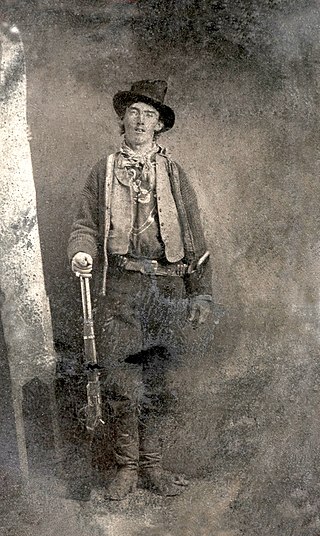
The Lincoln County War was an Old West conflict between rival factions which began in 1878 in Lincoln County, New Mexico Territory, the predecessor of the state of New Mexico, and continued until 1881. The feud became famous because of the participation of William H. Bonney. Other notable participants included Sheriff William J. Brady, cattle rancher John Chisum, lawyer and businessmen Alexander McSween, James Dolan and Lawrence Murphy.

Timothy Isaiah Courtright, also known as "Longhair Jim" or "Big Jim" Courtright, was an American Deputy Sheriff in Fort Worth, Texas from 1876 to 1879. In 1887, he was killed in a shootout with gambler and gunfighter Luke Short. Before his death, people feared Courtright's reputation as a gunman, and he reduced Ft. Worth's murder rate by more than half, while reportedly extracting protection money from town business owners.

John Henry Tunstall was an English-born rancher and merchant in Lincoln County, New Mexico, United States. He competed with the Irish Catholic merchants, lawmen, and politicians who ran the town of Lincoln and the county. Tunstall, a member of the Republican Party, hoped to unseat the Irish and make a fortune as the county's new boss. He was the first man killed in the Lincoln County War, an economic and political conflict that resulted in armed warfare between rival gangs of cowboys and the ranchers, lawmen, and politicians who issued the orders.

John Simpson Chisum was a wealthy cattle baron in the American West in the mid-to-late 19th century. He was born in Hardeman County, Tennessee, and moved with his family to the Republic of Texas in 1837, later finding work as a building contractor. He also served as county clerk in Lamar County. He was of Scottish, English, and Welsh descent.
John M. Larn was a western American lawman and later outlaw who, with gunfighter John Selman, operated a cattle rustling ring in Shackelford County, Texas, for over a year.

Frank M. Canton was an American Old West fugitive who had a career as a deputy U.S. marshal under an assumed name. Although an ex-sheriff stock detective in Wyoming, Canton and his associates were accused of operating more by assassination than the law. Extrajudicial measures such as the lynching of Ellen Watson inflamed public opinion against the long-established big ranchers Canton worked for, and to re-establish control over grazing they funded an all-out assault on those small operators considered to be rustlers. Canton directed Frank Wolcott's imported gunmen in their planned vigilante campaign, known as the Johnson County War, which was quickly ended by a local posse. Finding himself a marked man in Wyoming, Canton considered it opportune to leave the state. He spent most of the rest of his working life in law enforcement for the court of hanging judge Isaac Parker.

John Henry Selman was sometimes identified as an outlaw and sometimes a working lawman of the Old West. He is best known as the man who fatally shot John Wesley Hardin in the Acme Saloon in El Paso, Texas, on August 19, 1895.
The Lincoln County Regulators, or just the Regulators, were an American Old West deputized posse that fought in the Lincoln County War in New Mexico, during the late 19th century. They are well known for including Billy the Kid as a member.
The Jesse Evans Gang, also known as The Boys, was a gang of rustlers and robbers led by outlaw and gunman Jesse Evans, which lasted from 1876 until 1880. The gang was formed after Evans broke with the John Kinney Gang. After breaking away, he brought along with him Billy Morton, Frank Baker, Tom Hill, Dolly Graham, George Davis, Jim McDaniels, Buffalo Bill Spawn, Bob Martin, Manuel "Indian" Segovia and Nicholas Provencio.
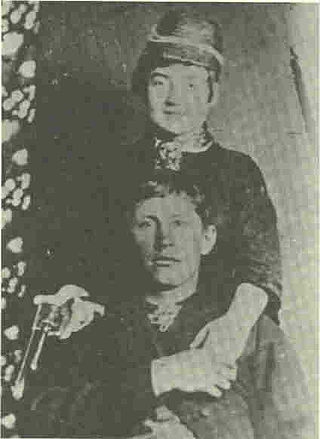
Jesse Evans was an American outlaw and gunman of the Old West, and the leader of the Jesse Evans Gang. He received some attention due to his disappearance in 1882, after which he was never seen or heard from again. Commentators speculated that Evans was living in Florida under the name Joe Hines in 1948, though no definitive proof was ever provided.
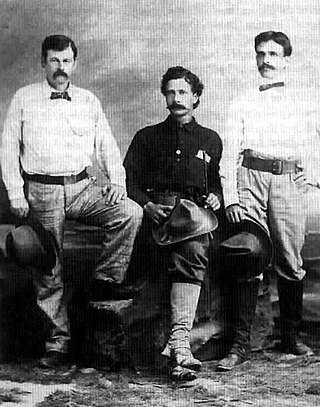
The John Kinney Gang, also known as the Rio Grande Posse, was an outlaw gang of the Old West which operated during the mid-1870s into the mid-1880s.
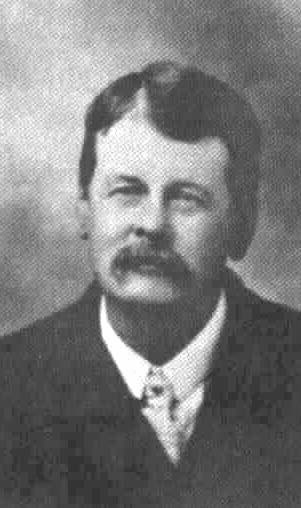
John Kinney was an outlaw of the Old West, who formed the John Kinney Gang.

George Peppin was a corrupt sheriff in Lincoln County, New Mexico, who figured prominently into the Lincoln County War.
The Seven Rivers Warriors was an outlaw gang of the Old West known primarily due to its part in the Pecos War and the Lincoln County War.

Lawrence Gustave Murphy was an Irish immigrant to the United States, Union Army veteran, Grand Army of the Republic member, Democratic Party ward heeler, racketeer, Old West businessman and gunman, and a main instigator of the Lincoln County War.
Abraham G. Graham, known by the alias "Shotgun" John Collins, was a little-known though well-associated gunfighter and outlaw of the American Old West.
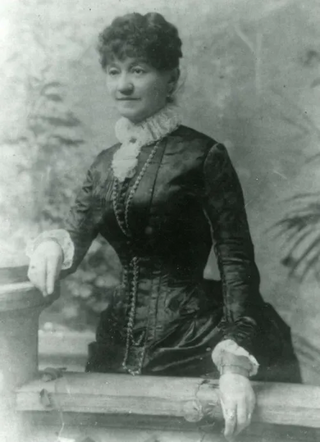
Susan McSween was a prominent cattlewoman of the 19th century, once called the "Cattle Queen of New Mexico", and the widow of Alexander McSween, a leading factor in the Lincoln County War, who was shot and killed by members of the Murphy-Dolan faction.
Roscoe "Rustling Bob" Bryant was a member of the John Kinney Gang during New Mexico's Lincoln County War. He was killed by members of Selman's Scouts near Seven Rivers, New Mexico in September 1878.

The Pecos War, also known as the War of the Pecos and the Chisum War, was a range war fought by cattle baron John Chisum against neighboring small ranchers, farmers, and Native Americans from 1876-1877 along the Pecos River in New Mexico. The conflict was caused primarily by competition: Chisum believed that his livestock and other resources were being depleted upon by people he alleged to be rustlers. At the same time, Chisum was also fighting Mescalero Apaches from the nearby reservations who were said to prey on his herds.
References
- ↑ Hunt, Frazier (2009). The Tragic Days of Billy the Kid: Facsimilie of 1956 Edition. Sunstone Press. p. 128. ISBN 9780865347175.
- ↑ Utley, Robert M. (1 December 1989). High Noon in Lincoln: Violence on the Western Frontier. UNM Press. p. 262. ISBN 9780826325464.
- 1 2 3 DeArment 1996, p. 66.
- ↑ Nolan, Frederick W. (2007). Tascosa: Its Life and Gaudy Times. Texas Tech University Press. p. 356. ISBN 9780896726048.
- ↑ Fulton, Maurice Garland (1980). History of the Lincoln County War. University of Arizona Press. p. 291. ISBN 9780816500529.
- ↑ Obert, Jonathan (18 October 2018). The Six-Shooter State: Public and Private Violence in American Politics. Cambridge University Press. p. 208. ISBN 9781108593632.
- ↑ Estes, Ralph (1 March 2021). Aces and Eights: Poker in the Old West. Rowman & Littlefield. p. 135. ISBN 9781493049639.
- ↑ DeArment, Robert K. (1 August 2005). Robinson III, Charles M. (ed.). Bravo of the Brazos: John Larn of Fort Griffin, Texas. University of Oklahoma Press. p. 160. ISBN 9780806137148.
- ↑ Thrapp, Dan L. (1 August 1991). Encyclopedia of Frontier Biography: G-O. U of Nebraska Press. p. 555. ISBN 9780803294196.
- 1 2 Mills 2022, p. 319.
- ↑ Treadwell, Terry C. (26 May 2021). Lawmen of the Wild West. Frontline Books. ISBN 1526782340.
- ↑ DeArment 1996, p. 64-65.
- ↑ Groves, Melody (1 April 2021). "When Outlaws Wore Badges". Rowman & Littlefield. p. 130. ISBN 9781493048045.
- ↑ Markley, Bill (27 September 2019). Billy the Kid and Jesse James: Outlaws of the Legendary West. Rowman & Littlefield. p. 194. ISBN 9781493038398.
- 1 2 Mills 2022, p. 289.
- ↑ Cain, Del (16 January 2001). Lawmen of the Old West: The Bad Guys. Taylor Trade Publications. p. 148. ISBN 9781556228346.
- ↑ Metz, Leon Claire (2002). The Encyclopedia of Lawmen, Outlaws, and Gunfighters. Infobase Publishing. p. 217. ISBN 9781438130217.
- 1 2 3 DeArment 1996, p. 65.
- ↑ O'Neal, Bill (1979). Encyclopedia of Western Gunfighters. University of Oklahoma Press. p. 278. ISBN 9780806123356.
- 1 2 Dolan 2020, p. 95.
- ↑ Cusic, Don (16 October 2014). The Trials of Henry Flipper, First Black Graduate of West Point. McFarland. p. 142. ISBN 9780786480425.
- ↑ DeArment 1996, p. 66-67.
- 1 2 DeArment 1996, p. 67.
- ↑ Dolan 2020, p. 96.